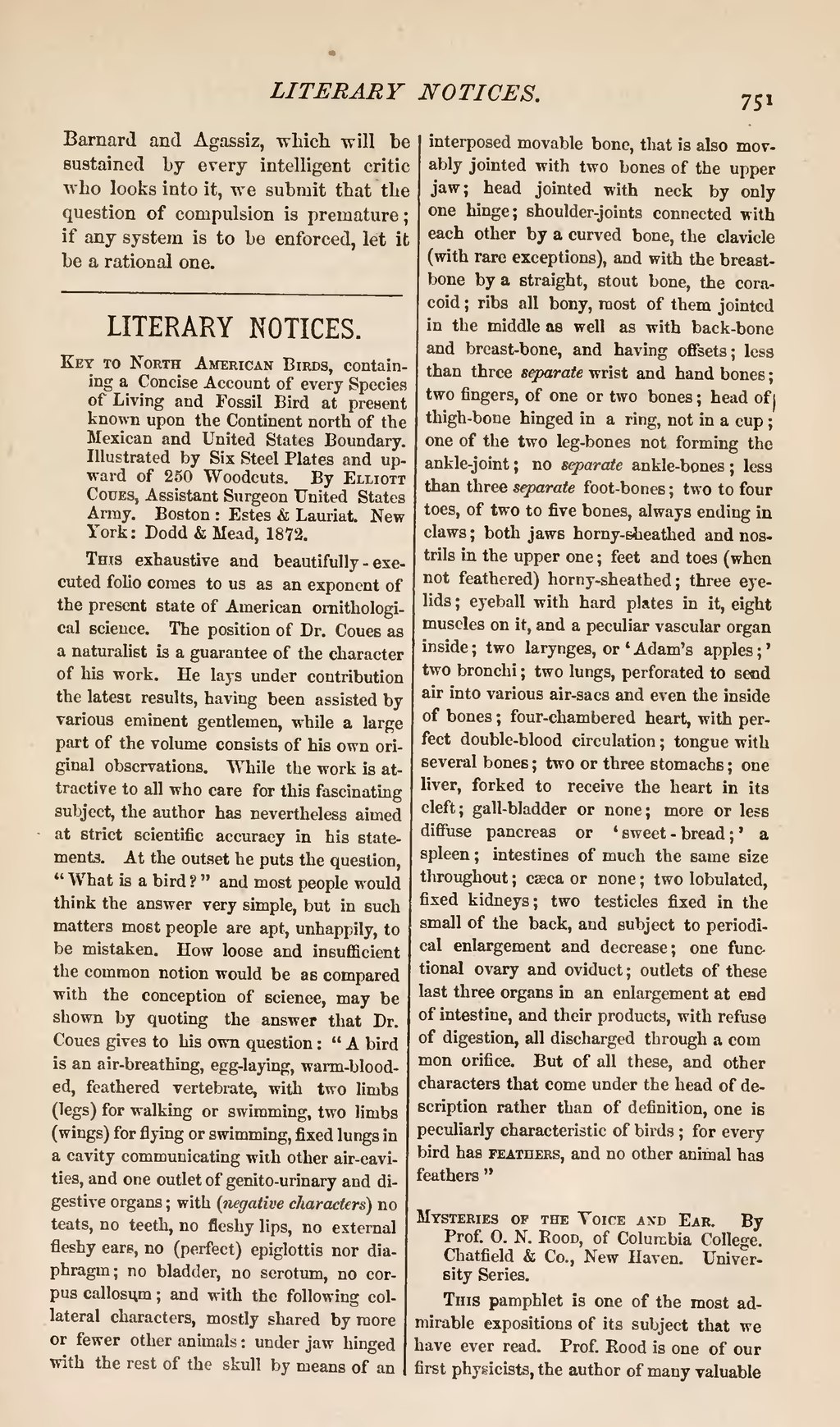Barnard and Agassiz, which will be sustained by every intelligent critic who looks into it, we submit that the question of compulsion is premature; if any system is to be enforced, let it be a rational one.
Key to North American Birds, containing a Concise Account of every Species of Living and Fossil Bird at present known upon the Continent north of the Mexican and United States Boundary. Illustrated by Six Steel Plates and upward of 250 Woodcuts. By Elliott Coues, Assistant Surgeon United States Army. Boston: Estes & Lauriat. New York: Dodd & Mead, 1872.
This exhaustive and beautifully executed folio comes to us as an exponent of the present state of American ornithological science. The position of Dr. Coues as a naturalist is a guarantee of the character of his work. He lays under contribution the latest results, having been assisted by various eminent gentlemen, while a large part of the volume consists of his own original observations. While the work is attractive to all who care for this fascinating subject, the author has nevertheless aimed at strict scientific accuracy in his statements. At the outset he puts the question, "What is a bird?" and most people would think the answer very simple, but in such matters most people are apt, unhappily, to be mistaken. How loose and insufficient the common notion would be as compared with the conception of science, may be shown by quoting the answer that Dr. Coues gives to his own question: "A bird is an air-breathing, egg-laying, warm-blooded, feathered vertebrate, with two limbs (legs) for walking or swimming, two limbs (wings) for flying or swimming, fixed lungs in a cavity communicating with other air-cavities, and one outlet of genito-urinary and digestive organs; with (negative characters) no teats, no teeth, no fleshy lips, no external fleshy ears, no (perfect) epiglottis nor diaphragm; no bladder, no scrotum, no corpus callosum; and with the following collateral characters, mostly shared by more or fewer other animals: under jaw hinged with the rest of the skull by means of an interposed movable bone, that is also movably jointed with two bones of the upper jaw; head jointed with neck by only one hinge; shoulder-joints connected with each other by a curved bone, the clavicle (with rare exceptions), and with the breast-bone by a straight, stout bone, the coracoid; ribs all bony, most of them jointed in the middle as well as with back-bone and breast-bone, and having offsets; less than three separate wrist and hand bones; two fingers, of one or two bones; head of thigh-bone hinged in a ring, not in a cup; one of the two leg-bones not forming the ankle-joint; no separate ankle-bones; less than three separate foot-bones; two to four toes, of two to five bones, always ending in claws; both jaws horny-sheathed and nostrils in the upper one; feet and toes (when not feathered) horny-sheathed; three eyelids; eyeball with hard plates in it, eight muscles on it, and a peculiar vascular organ inside; two larynges, or 'Adam's apples;' two bronchi; two lungs, perforated to send air into various air-sacs and even the inside of bones; four-chambered heart, with perfect double-blood circulation; tongue with several bones; two or three stomachs; one liver, forked to receive the heart in its cleft; gall-bladder or none; more or less diffuse pancreas or 'sweet-bread;' a spleen; intestines of much the same size throughout; cæca or none; two lobulated, fixed kidneys; two testicles fixed in the small of the back, and subject to periodical enlargement and decrease; one functional ovary and oviduct; outlets of these last three organs in an enlargement at end of intestine, and their products, with refuse of digestion, all discharged through a common orifice. But of all these, and other characters that come under the head of description rather than of definition, one is peculiarly characteristic of birds; for every bird has feathers, and no other animal has feathers."
Mysteries of the Voice and Ear. By Prof. O. N. Rood, of Columbia College. Chatfield & Co., New Haven. University Series.
This pamphlet is one of the most admirable expositions of its subject that we have ever read. Prof. Rood is one of our first physicists, the author of many valuable
